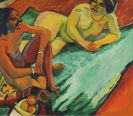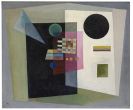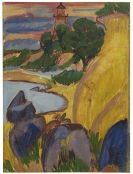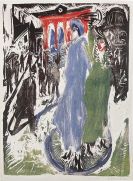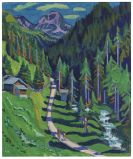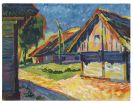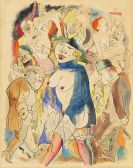
Carlo Mense
Rheine/Westfalen
1886 -
Königswinter
1965
Carlo Mense was born on 13 May in Rheine, Westphalia. To please his father, he began commercial training but broke it off to devote himself to painting. After military service he enrolled at the Düsseldorf Academy in 1906, where he studied under Peter Janssen, who specialised in history paintings and paintings on a grand scale. On a trip to Italy with his brother Rudolf, Carlo Mense ended up in Ascona, where he came into contact with reformist movements which would exert a lasting influence on his life.
After Janssen's death in 1908, Carlo Mense followed a suggestion made to him by August Macke and went to Berlin to study under Lovis Corinth. He left the city, however, after winter term to continue his studies in Weimar and Munich. In 1910-11 the young painter settled in the Rhineland and joined the recently founded "Cölner Sezession" and the "Gereon Club". By 1912 Mense was showing paintings at the legendary Sonderbund Exhibition in Cologne and was represented with work in 1913 at the "Rhinish Expressionists" exhibition started by August Macke in Bonn.
This led to contact with Herwarth Walden, to whose magazines "Die Aktion" and "Der Sturm" Carlo Mense contributed prints. Close ties of friendship linked Mense with Heinrich M. Davringhausen, who accompanied him in 1914 on his second trip to Ascona.
When world war I broke out, Mense was conscripted and did not return to the Rhineland until the war was over. Mense then became a leading member of the "Gesellschaft für Kunst" ["Art Society"], which founded the periodical "Der Strom". In 1918-19 he also joined the artists' associations "Das Junge Rheinland" ["Young Rhineland"] and the "Novembergruppe" ["November Group"].
After his marriage to Vera Baske, he often stayed in Munich, where he cultivated close links with Paul Klee and the Schwabing art scene. Consequently, his circle of close friends included Oskar Kokoschka, Josef Eberz, Georg Schrimpf and above all Richard Seewald. In 1923 Alexander Kanoldt joined it.
Since artists were in dire financial straits at the time, Carlo Mense stayed in Positano for quite some time, Richard Seewald and other painters joined him there. While Mense was in Italy, the art critic Franz Roh managed the sale of his pictures. Finally, in 1925 Carlo Mense was appointed professor at the state Academy for the Fine and Applied Arts in Breslau, where he became friends with Oskar Schlemmer. In 1932, however, the Breslau Academy was closed and Mense lost his position. The award of the Rome Prize ensured him a grant until summer 1934.
In the course of the confiscation of "degenerate art", 34 paintings by Mense were removed by the National Socialists from public collections. Carlo Mense saw military service in world war II until early in 1944, when he settled in Bad Honnef after his studio had been destroyed in the bombing raids. For a while nothing more was heard from him until 1956, when he had a one-man show of his work in Königswinter on the occasion of his 70th birthday.
Would you like to sell a work by Carlo Mense?
Infos for seller
